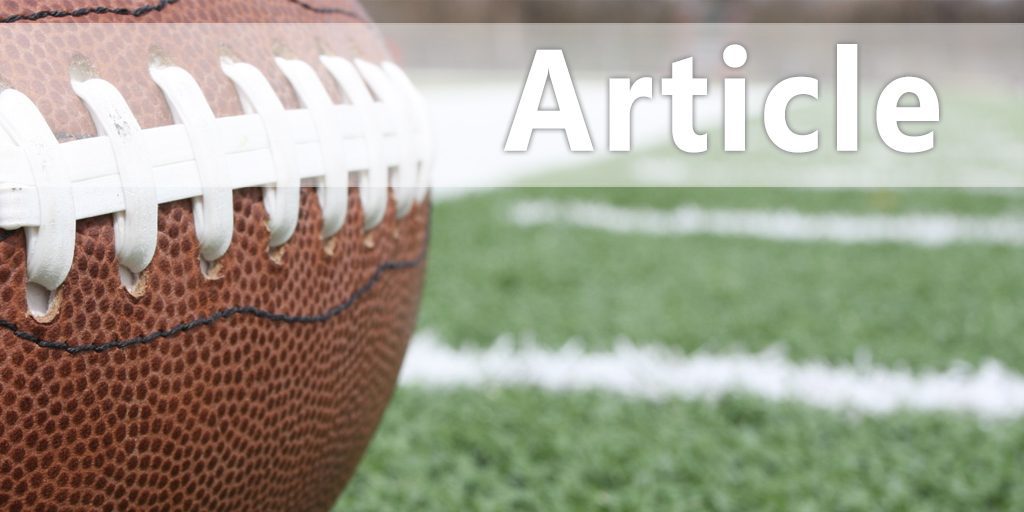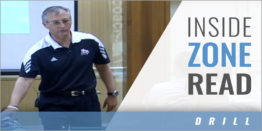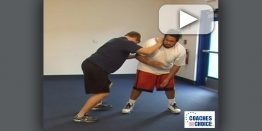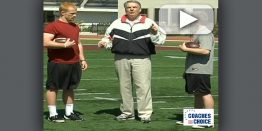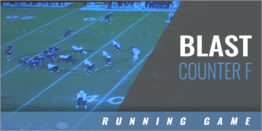| Three Effective Types of Screen Passes
When I first started coaching at Mayfield, we were a wishbone team. We ran power off-tackle, counter trey, and the bootleg. Do not get me wrong; I still love that stuff. The makeup of our kids made us change to a spread offense and a no-huddle team. We do a lot of screens and a lot of quick passes in order to get the ball to our best athletes. It has been a great change for us. Our kids love playing in it. We took a couple of kids who weighed about 140 pounds off the basketball court, and they became very successful in our spread offense. I am going to talk to you today about our screen passing game. I will cover our fast screen, solid screen, and jailbreak screen. They have been very successful for us over the past years.
Screens allow us to get the ball into our best athletes' hands and do it very quickly. We have a couple of receivers; one weighs about 140 pounds, and another about 150 pounds, and he can run. They are very good athletes. If we put them in a two-tight-end wishbone formation, those guys could not make plays for us. We throw the ball out there to them and let them do their thing. They got better and tougher as the year went along. Our offensive linemen get tired of taking on 250-pound defensive linemen or butting heads with 190-pound linebackers. My offensive linemen get to run around and hit little defensive backs. Every day in practice, we have a time period called "team screens," and they get to run around and hit little defensive backs. They love it. Those guys run out there, and they may not even make a block, but they may get in their way. Sometimes, they do not make a good block, and it still will work. For some reason, it makes our guys work harder, knowing that they get to go out and block little guys. Even if the screen only goes for two yards and does not work, it makes the defensive line run from sideline to sideline. I know we put our best lineman on the defensive line, and some of them go both ways. The very first play we ran in the state championship was a fast screen. Our opponent had done a great job of scouting us and their defensive tackle got out there real quick and forced us to cut back. I think we gained about 10 yards on the play. In the fourth quarter, that 260-pound defensive tackle was not getting out there as fast. He was tired. We were in the shotgun or no-huddle most of the game. Screens may not work early, but they will work late. If you try to run the ball early and are unsuccessful, I believe that if you run a bunch of screens, you can be successful running the ball later in the game. We believe we can throw the screen in just about any situation. In a scrimmage this year against a very good team from Tennessee, we threw the jailbreak screen on third-and-three, down on the three-yard line. We had tried to run the ball on the first two plays and got nothing. I knew we were going to throw the ball, but my offensive coordinator called the jailbreak screen. I thought, "What is he doing?" We ran the play, our offensive linemen did not have to block anybody, and we walked into the end zone. You can throw the screen in just about every situation, except for forth-and-one. I will not let Coach Hatchell call a screen in that situation. We found our screens work very well against the blitz. I believe some of the teams we faced would not blitz us because of our screens. If we would see a team getting ready to blitz us or in press coverage, we would run a solid screen or jailbreak screen, and we would make people pay. It also makes everything easier for our pass protection. We practice our screens every day. When we are in our team period, at the end of practice, Coach Hatcher is going to script 6 to 10 screens for us to practice, every day. In our warm-up drills, we are going to throw 15 to 20 screens. Every day, our quarterback is going to practice the fast screen, the solid screen, and the jailbreak screen. We practice team screens together as a group. This is where we get our offensive linemen all jacked up because they get to go and hit the little guys. We do put a defense over there to run against. We do it no-huddle, and our coach is yelling out the plays, so we can get as many repetitions as possible. We will put the ball on the 15-yard line going in, and we will score. We throw about 40 to 50 screens per day. It does not take us very long at all to do that. I feel this is why we have become good at throwing screens. Let me go over our fast screens. As I said before, we are a no-huddle football team. When we throw a fast screen, 95 percent of the time it is going to be off of a freeze play. Either that, or the defense is leaving somebody uncovered, or they are in soft coverage. We have found that if the defense is up in our face and we try to run a fast screen, it does not work. When we call a pass play, all of the 40s are to the right and 50s are to the left. Our guys have to be able to count. We can call 41, 42, 43, and 44, depending on the formation. If we call a 41, and I am the first receiver out there, I know I am getting the ball. 41 is to the right (Diagram #1).  We tell the Z-receiver, who is catching the ball, to put his near foot up. He is going to take one step, get his hands up, and then he is going to get the ball. I do a great job of coaching the receivers. When they catch the ball, I tell them to, "Get five yards, and then let the good Lord take over." I tell them to, "Go be an athlete, and go beat somebody, but give me five yards." I will take five yards every time. We have tried blocking this several ways. These are our general rules for our Ace 41 screen. 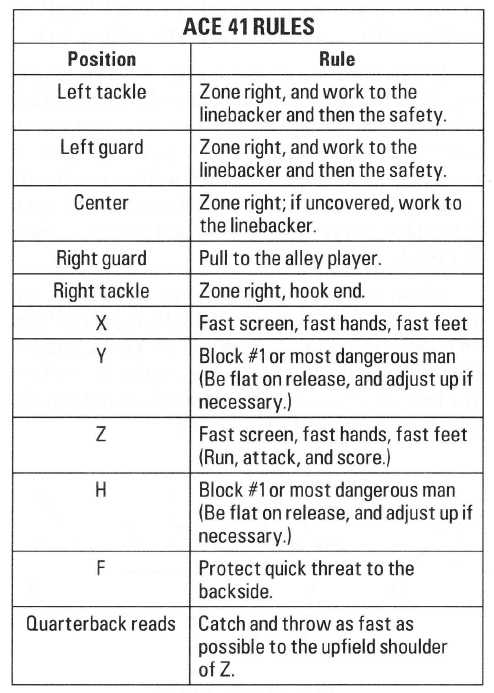 Our left and right guards will take their zone step and get to the next level. They do not have to worry about blocking the down lineman. The F-back will take a step up and protect the backside so the quarterback does not have to take a hit. The quarterback, on the fast screen, is going to catch the ball and get it out as fast as he can. We work on it a lot. He does not grip the laces; he gets it in the receiver's hands, as fast as possible. We can run the same thing out of a trips set (Diagram #2). The only difference is the H-back becomes the blocker on the most dangerous defender. Most of the time, we put the F-back away from the screen. We can change that, depending on how the defense lines up. 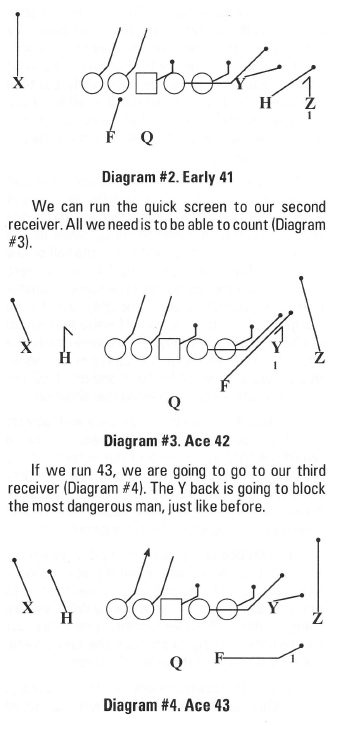 Our quick screens are not very good when the defense plays press coverage. The exception is when we throw it to our back. We can run it in our trips set (Diagram #5). If the defense does not adjust to the trips formation, we can outnumber them. We run off all the defenders on our trips receivers, and throw it to the back. Any 40 play is blocked the same for our offensive lineman. This time, we put the F-back to the trips side. We just throw an easy completion for the quarterback, and get the ball in the fast guy's hands.  We can run the same plays to the left side. The only difference is we call it 50 (Diagram #6). The H-back is not told he has to kick out the corner. He just has to square up and occupy him. Most of the time, it does end up being a kick-out, but it does not have to be. We tell the receiver that it is his job to break off of that block. Everything else is just the same.  We can run the quick screen to the left, away from the trips side. We like to do this against man coverage (Diagram #7). The linemen need to know two plays. They need to know 41 and 51. The blocking for all the other 40 and 50 plays is the same. The receivers need to know how to count. The key is to get the ball to our athletes in space. 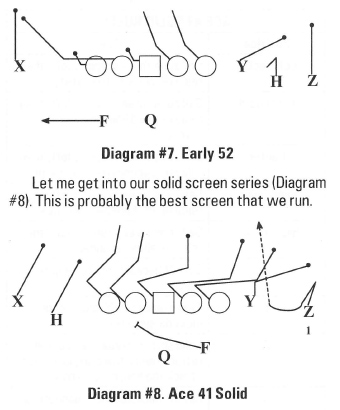 We tell him to come back about half to three- quarter speed, and to get behind the line of scrimmage. The other difference is our Y-receiver now drives up two steps and kicks out #1, or the most dangerous man. Before, he was going flat. As I said, we run a lot of zone. Our best running play is a 33 zone play. It is just a regular inside zone play. Every one of our linemen is going to zone-step. Our quarterback is going to fake the zone play. Our tackle, after he takes his zone step, is going to come out and get the second-most dangerous man. All the other linemen take a zone step and then get to the next level. We like this type of play against the blitz and against press coverage. Most of the time, we will run this to our outside receivers, a 41 or a 51. It has been most successful to our outside receivers. We can run this out of our early (trips) set (Diagram #9). The biggest thing we need to do is sell out on our zone step. Our offensive line was not very big, but we were athletic. They like running this type of offense. 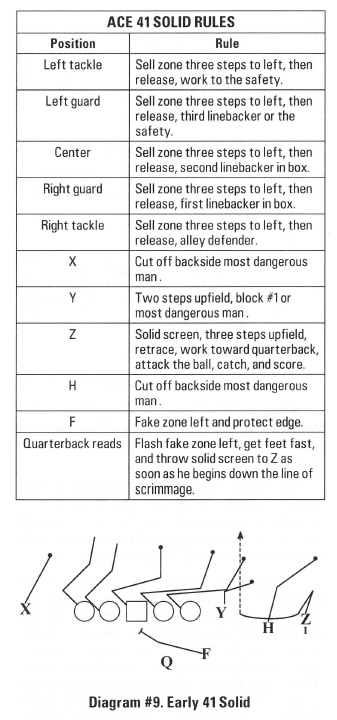 Our early 42 solid is very similar, except for now it is the #2 receiver getting the ball (Diagram #10). Our back drives up three steps, retraces his steps, catches the ball, and gets upfield at least five yards. We can run it from any formation. The only thing we do not do is run it to our back. We only run it to our receivers. 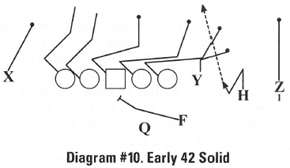 On 51 solid, we are faking the zone step to the right (Diagram #11). We are going to throw it back to the left. On the fast screen, we do not kick out. On the solid screen, his job is to kick out the first defender. We tell the running back that he is the one who sells the fake. The running back sells the fake more than the quarterback does. The running back will fake away on the solid screen. We can turn everything around and run everything to the left side. All we have to do is call 50. 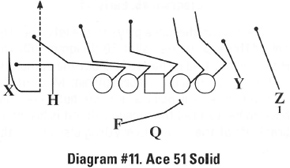 The last thing we have is our jailbreak screen (Diagram #12). The jailbreak screen is just like a solid screen for our receivers. Our Z-back may have to come more inside to the line of scrimmage because of what our quarterback does. The F-back is lined up away from the play. As soon as the ball is snapped, he swings. 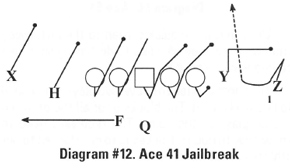 The biggest difference is that the tackle to the playside will try to push the defensive end up the field. We feel that we have to block him. He is the only one whom we feel can stop this play. The tackle really sells the pass to try to get the defensive end up the field. The rest of our linemen run our 90 pass set. That means they block just like our shotgun pass. They drop back, show their hands, and release toward the playside. 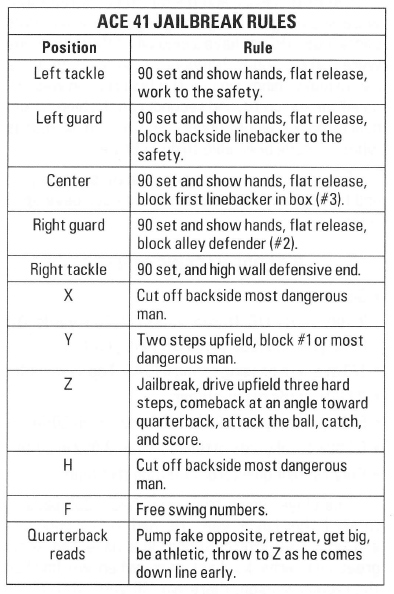 For the quarterback, there is no fake. When he catches the ball, the first thing he is going to do is look the opposite way. He might even pump to the left. After he makes the pump, he backs up three steps and finds a way to get the receiver the ball. There will be guys coming after him. The quarterback does not have to look pretty; he may even lob it just over the defenders. I have found that our jailbreak screen works better against a good football team. I did not realize how good the jailbreak screen was for us until I started putting together the cut-ups for my presentation. It was a great third-and-long play for us. We run this play to the outside receiver most of the time as well, because we want to get the ball to our fastest receiver. We can also run the jailbreak in the trips formation (Diagram #13). 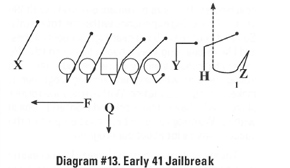 Our screen package has been very good to us. Please feel free to give me a call anytime at Mayfield High School. I will be glad to go over this with you. Good luck to you next season. Thank you very much.
|
